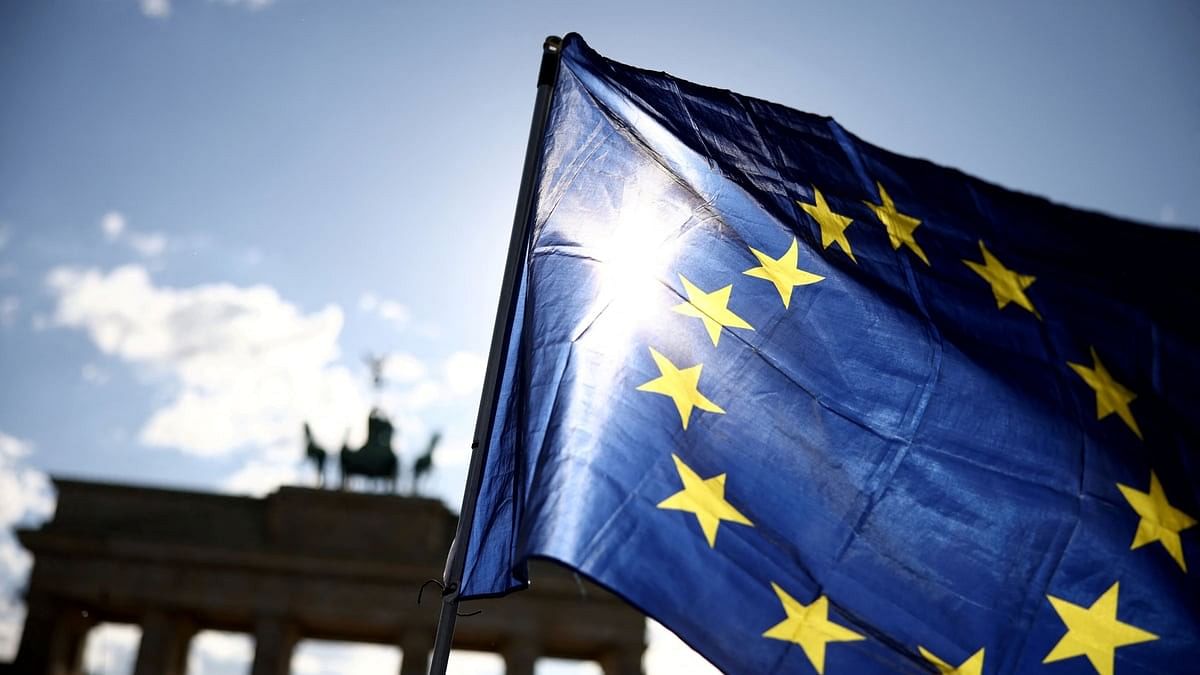
EU flag.
Credit: Reuters Photo
More than 300 million voters in the 27 countries that make up the European Union are heading to the polls to elect the new European Parliament’s 720 members. But in casting their ballots they’ll do more than that.
The new balance of power in the Parliament will shape the next five years of important European policies at home and abroad, including on climate, migration, Ukraine and the Middle East.
The Parliament approves or rejects EU legislation, including the bloc’s $1 trillion-plus budget and the bloc’s top leadership. It also says yea or nay, by simple majority in a secret ballot, to the appointment of the president of the EU executive branch, the powerful European Commission.
In the 2019 election, Ursula von der Leyen, a conservative, came dangerously close to being rejected as the European Commission president, securing the Parliament’s approval by just nine votes. This time, von Leyen, likely to be designated as president for a second five-year term, could face worse odds. As with many incumbents, she is criticized for her handling of the last five years’ crises.
Polls predict gains for hard-right parties in the Parliament and a shrinking center. This could force her to cut a deal with radical right-wing parties to get appointed, and in the process risk losing centrist support.
A handful of countries began voting Thursday, but the vast majority vote Sunday. Polls close at different times around the bloc, but projected results should be in after 6:30 pm local time (12:30 EDT).
Here are the key trends that have been projected.
The Center May Not Hold
Political parties run in their respective countries, but once they enter the European Parliament, they form superparties, banding together in like-minded groups.
The largest of these has traditionally been the mainstream conservative European People’s Party, which dates to the 1950s. The group includes major center-right parties like the Christian Democratic Union of Germany and the Republicans of France. Von der Leyen is a member. The European People’s Party is projected to maintain its top position in the vote, performing only slightly worse than in 2019.
The two other centrist groups are expected to lose seats. The Socialists & Democrats, the biggest left-leaning centrist group, is projected to lose some 10 per cent of its seats.
The other, Renew Europe, a smaller liberal group, has been dominated by French President Emmanuel Macron’s centrists since 2019. But divisions on issues like the environment and business have weakened its influence. It is expected to lose 20 per cent of its seats.
Fragmented Far Right
Polling foreshadows big gains for far-right parties that run on a spectrum of antimigrant, nationalist agendas. But it’s a crowded, splintering space led by competing personalities.
The European Conservatives and Reformists are projected to secure fourth place in the new Parliament with a possible 30% more seats than in 2019 — a feat. They are led by Prime Minister Giorgia Meloni of Italy, whose insider/outsider status in the EU establishment may make her the kingmaker after the results come in. If the center weakens, as predicted in the polls, von der Leyen will have little choice but to turn to Meloni for support.
This will irk other centrists, who suspect Meloni of being a radical right-winger in mainstream conservative clothes and criticize her for antimigrant statements and domestic policies like laws limiting gay rights.
Predicted to finish fifth, but much stronger than in 2019, is the Identity and Democracy group, led by far-right nationalist Marine Le Pen. This group is more deeply antiestablishment and populist, and it has hard-line antimigrant views. It has been in some turmoil in recent weeks, expelling its German member, Alternative for Germany.
An important distinction between the two groups is their perspective on relations with the United States. Le Pen is seen as pro-Russia, whereas Meloni has been unwavering in her support of Ukraine. It’s a big thing to set aside, but, if they did, they could be the second-largest group in the European Parliament.
Green Grind
The Greens did very well in the 2019 elections, finding a special place for their ambitious agenda in the Parliament. But they are predicted to lose a third of their seats this time around, stemming from a combination of factors. Many voters see the key elements of the climate change agenda reflected in the mainstream and don’t see why they should vote for the Greens. Others, particularly rural voters, feel the green agenda has gone too far.
Finally, The Left, the Parliament’s most left-wing party, is expected to hold more or less steady.
A Caveat
Polls everywhere have often been way off in recent electoral cycles for a variety of reasons. A particular complicating factor is that the EU elections happen in 27 countries, and the robustness of the polling comes down to very local factors. Experts note that polls often overestimate the far right and underestimate the fervor of pro-EU and pro-Green voters who are highly motivated and disciplined.
If the Dutch elections for the European Parliament, which took place Thursday, before many other countries, are anything to go by, some of those warnings are fair. In the Netherlands, where a far-right party dominated national elections recently and was gunning for first, the Greens and Socialists came in on top instead, reporting a strong 80% turnout in their supporters’ ranks.